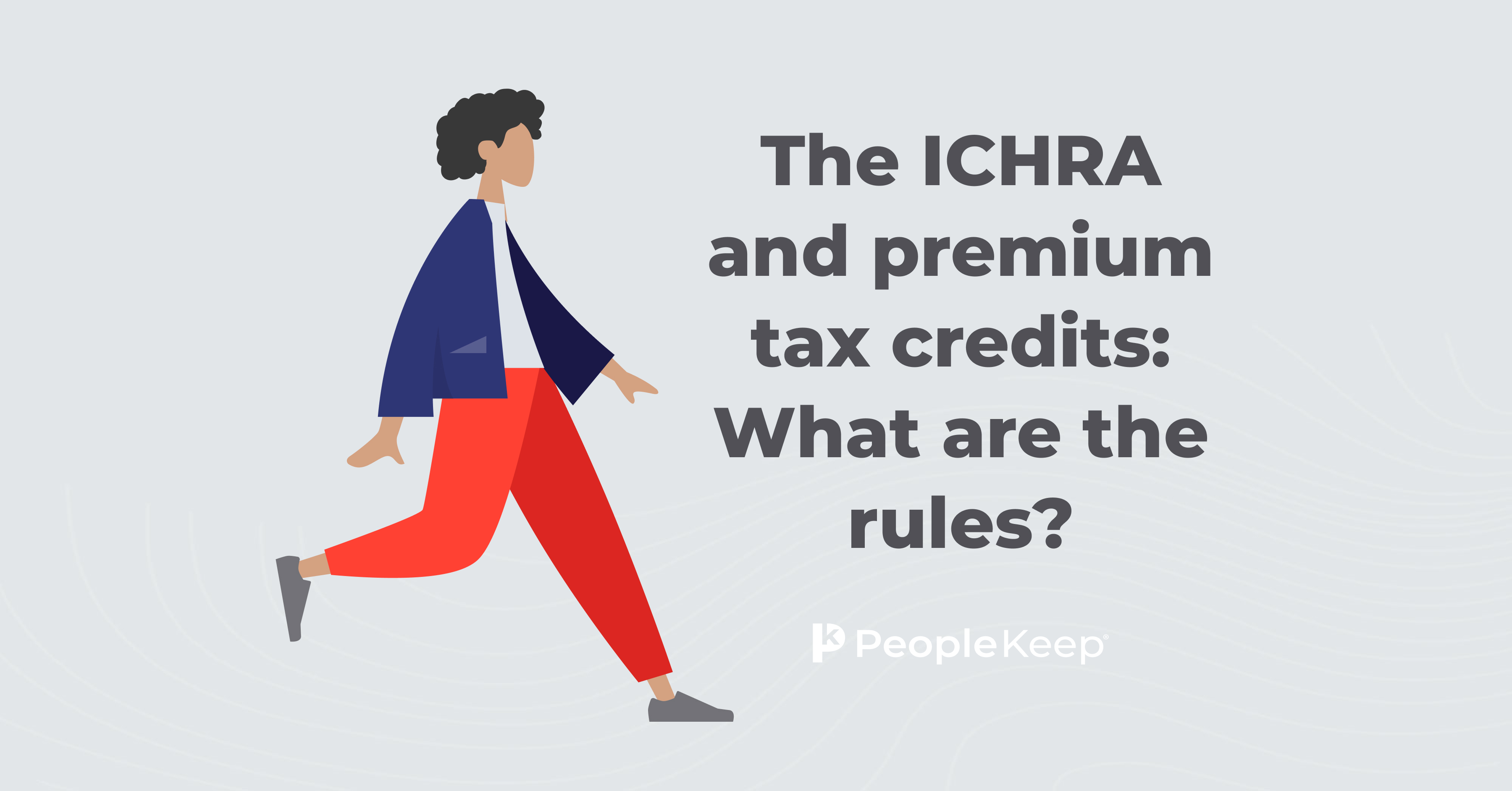How to use group health insurance with an HRA
By Holly Bengfort on May 16, 2023 at 10:39 AM
When it comes to offering a health benefit to their employees, many employers look to group health insurance. According to the Kaiser Family Foundation (KFF), nearly half of insured Americans have health insurance coverage through their employer's group health plan. However, a health reimbursement arrangement (HRA) is another option employers can offer to cover their employees’ medical expenses.
So which should your organization use—a traditional group health plan or one of the many types of HRAs? Thanks to the group coverage HRA (GCHRA), employers can offer both group health insurance and an HRA together to make their employees’ well-being even more affordable.
In this article, we'll go over how group health insurance can be used with a GCHRA, what medical expenses a GCHRA covers, and how the combination of group health insurance and a GCHRA can make your healthcare expenses more affordable.
Want the highlights? Get our guide on everything you need to know about the GCHRA
What is the group coverage HRA (GCHRA)?
The GCHRA, often called an integrated HRA, is a reimbursement arrangement between an employer and their employees to help pay for out-of-pocket costs that aren't covered under the traditional group health plan. Employers reimburse their employees for qualifying expenses on a tax-free basis.
Unlike a traditional integrated HRA offered by an insurance company, employers who administer their GCHRA through PeopleKeep aren't restricted to compatible plans through any individual provider. Plus, they can keep their HRA even if they change insurance providers.
Many employers who offer a traditional group health insurance plan face annual rate hikes and high premium costs that are often difficult to manage. In these cases, switching to a high-deductible health plan (HDHP) and pairing it with a GCHRA can help bridge the gap between offering a group plan and minimizing monthly premium costs.
What can I get covered through a GCHRA?
While your group health insurance plan will cover portions of your employees’ doctor's visits, prescriptions, and other health costs, they can use their GCHRA allowance to cover many things your insurance doesn't.
Qualifying medical costs
The GCHRA covers a wide range of items that your insurance may not cover in full or at all, including prescriptions, cold medicine, bandages, glasses, sunscreen, and so much more. You can find a list of all eligible items in IRS Publication 502. However, employers can limit these items further.
All your employees have to do is pay for these items like they normally would, then submit the receipt for reimbursement. Once you approve the expense, they’ll receive a tax-free reimbursement on their next paycheck or through a direct deposit.
Copays
If your group health insurance requires a copay for doctor's visits, your employees can also get that charge reimbursed tax-free through a GCHRA.
For example, let's say they go to the doctor and receive a charge of $100 for the visit. While their insurance covers the cost of the visit, they’re still charged a $20 copay. Rather than paying for that charge on their own, you can reimburse them with their GCHRA allowance.
Pre-deductible costs
Most group health insurance plans require a deductible to be paid before they will cover anything—that's where your GCHRA comes in handy, especially with high deductible plans.
Before your employees meet their deductible, they can use their tax-free dollars from the GCHRA until their deductible is paid in full and their insurance starts covering their medical costs, or until they’ve used all of the funds from their GCHRA allowance—whichever comes first.
Depending on how you design your benefits plan, you may also set a deductible on your GCHRA in addition to the deductible that is set for your group health insurance policy. If that’s the case, your employees will need to meet that before they can use their allowance.
Do my employees have to pay for anything out of pocket with a GCHRA?
While it depends on how you choose to design the benefit, your employees will likely pay for a few things on their own in addition to the things they can get reimbursed for.
With the GCHRA, employers can control costs beyond setting an allowance by setting up a deductible. They can set any dollar amount (usually between $150 and $500) that employees must personally meet with their healthcare costs before being eligible to receive reimbursements.
Along with the deductible, employers can choose to make their employees responsible for a percentage of each eligible medical expense. So with each expense that's considered reimbursable, employers can define how much employees must cover on their end.
For example, an employer could choose to cover 85% of all medical expenses up to the total allowance, while employees are required to cover 15% themselves. This type of arrangement is generally referred to as cost-sharing or coinsurance.
How much money is in a GCHRA allowance?
The nice thing about the GCHRA benefit is there isn't a minimum or maximum limit on how much your monthly allowance can be. That means your allowance will be however much you decide to offer to your employees. This gives you complete cost control over your benefits.
Employers can also decide to give out different allowance amounts to different classes of employees. For example, a part-time employee may only get $100 a month, while full-time employees get $500 a month.
Can my employees use a GCHRA to pay for group health insurance premiums?
Because it is meant to be paired with employer-sponsored group coverage, the GCHRA will not allow employees to be reimbursed for insurance premiums of any kind because there's no way to prevent “double-dipping.”
Double-dipping is where you get a tax break twice on the same premium payment—which isn't allowed under Internal Revenue Service (IRS) rules. With job-based health insurance, the vast majority of premium payments are made by employees as a pre-tax payroll deduction.
So if your employees use their GCHRA allowance (which is also tax-free) to pay their premiums, you've created a double-dipping issue where they’re using tax-free dollars to pay for a pre-tax deduction.
The IRS won't let that kind of thing slide, so your employees need to pay for group health insurance premiums with their own money, not their GCHRA allowance.
Can I offer an individual coverage HRA and a group health plan?
In some cases, employers can offer another type of HRA alongside group health insurance— the individual coverage HRA (ICHRA). With an ICHRA, employees who have their own individual health insurance coverage can be reimbursed for their medical care expenses by their employer.
It’s important to note that employees who participate in your group health policy cannot participate in an ICHRA. If an employer offers both a group health insurance plan and the ICHRA, each benefit must be offered to different types of employees.
For example, an employer can offer group health insurance to full-time employees and the ICHRA to part-time employees. Or, seasonal employees may get the ICHRA while salaried employees get group health insurance.
However it's divided up, the employee can never have a direct choice between whether they get the group health insurance plan or the ICHRA—they'll get whatever benefit is offered to their employee class, as set up by their employer.
Under current rules, employees can either participate in an ICHRA and waive their premium tax credits, or they can opt-out and collect premium tax credits if the ICHRA is considered unaffordable. This can be determined using our affordability calculator.
Which insurance plans are accepted under the ICHRA?
There are special rules if your employee wants to have their medical care expenses reimbursed through an ICHRA. They need to have qualifying individual health insurance coverage.
Policies that are considered acceptable individual health insurance coverage include:
- Individual health plans
- Medicare
- Student health insurance coverage
Policies that aren't considered acceptable individual health insurance coverage include:
- Any kind of traditional group health plan, including a group plan from a spouse or a parent
- Association health plans
- COBRA
- Healthcare sharing ministries
- Self-insured student health insurance coverage
- Short-term limited duration insurance
- Tricare
Other types of HRAs
The qualified small employer HRA (QSEHRA) is another popular option among employers. While organizations of all sizes can offer an ICHRA or GCHRA, a QSEHRA is specifically designed for small businesses with fewer than 50 full-time equivalent employees (FTEs).
Like the ICHRA, a QSEHRA gives additional flexibility and choice for employees since they get to pick the health policy that they feel is best for them. You can then reimburse employees for their individual health insurance premiums and out-of-pocket medical expenses.
Unlike a traditional group health plan, the QSEHRA has no minimum limit for employer contributions, so you can offer the benefit to your employees even on a small budget. However, there are annual contribution limits with a QSEHRA. Every year, the IRS outlines these annual contribution limits through a revenue procedure.
As an additional rule, employees who receive monthly allowances through a QSEHRA must reduce their premium tax credit by the amount of their monthly allowance. Also, employees with a QSEHRA can’t choose to opt out of the benefit like they can with an ICHRA in order to collect their full premium tax credit.
You can’t offer a QSEHRA alongside a group health insurance plan.
Conclusion
A traditional group health plan is a common way organizations can provide employees with the health coverage they expect from their employer. Supplementing your employee benefits package with a GCHRA will help you stand out against your competition so you can better recruit and retain employees in today’s tight labor market.
By combining a group health plan coverage with a GCHRA, you stretch your health benefit dollars while helping your employees cover their qualified medical expenses. It's a flexible and low-cost benefit option that allows you to give your employees the essential coverage they deserve.
Check out more resources
See these related articles

The ICHRA and premium tax credits: what are the rules?
With an ICHRA, the allowance amount you offer your employees can impact their premium tax credit eligibility.

How does the ICHRA special enrollment period work?
Learn how the ICHRA special enrollment period (SEP) works. Understand eligibility, key dates, and how employees can enroll in individual health coverage.

How does ICHRA affect health insurance subsidies?
Learn how ICHRA affects health insurance subsidies. Understand if employees receiving subsidies will be impacted by an employer's ICHRA offering.


